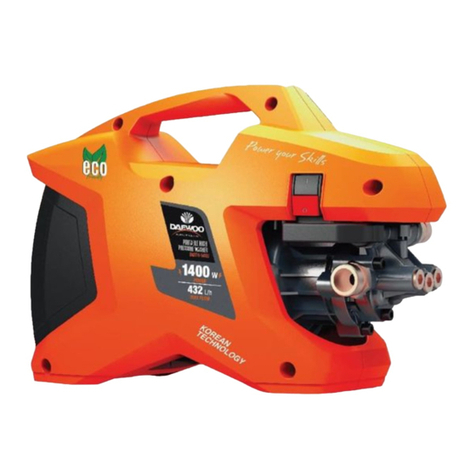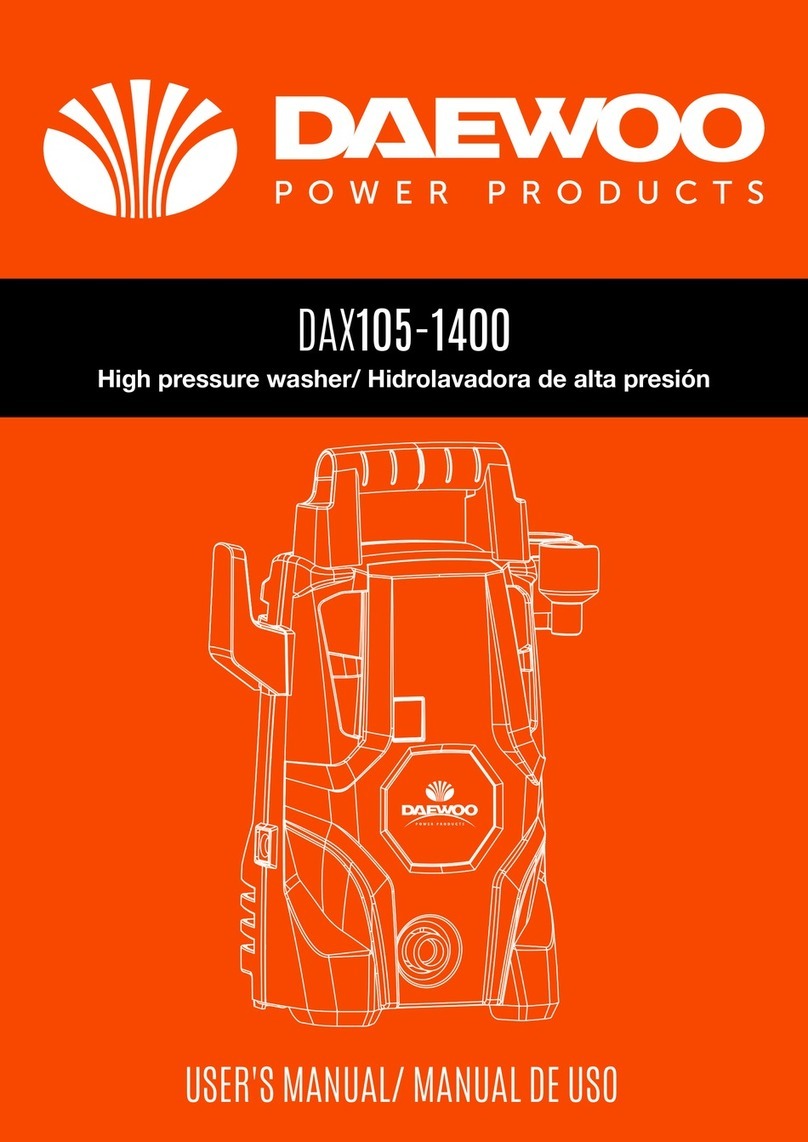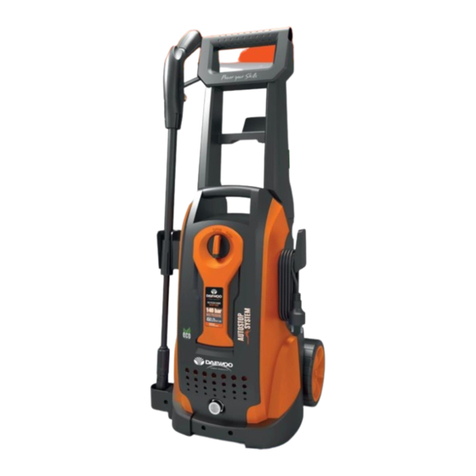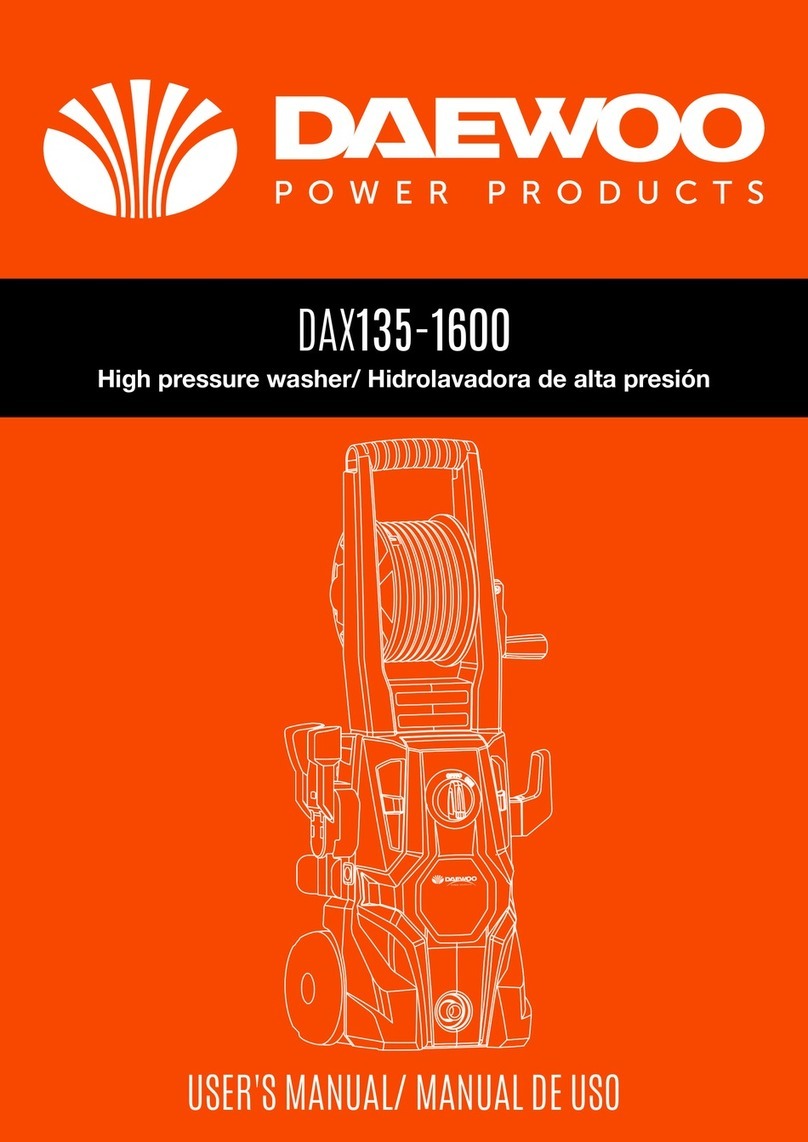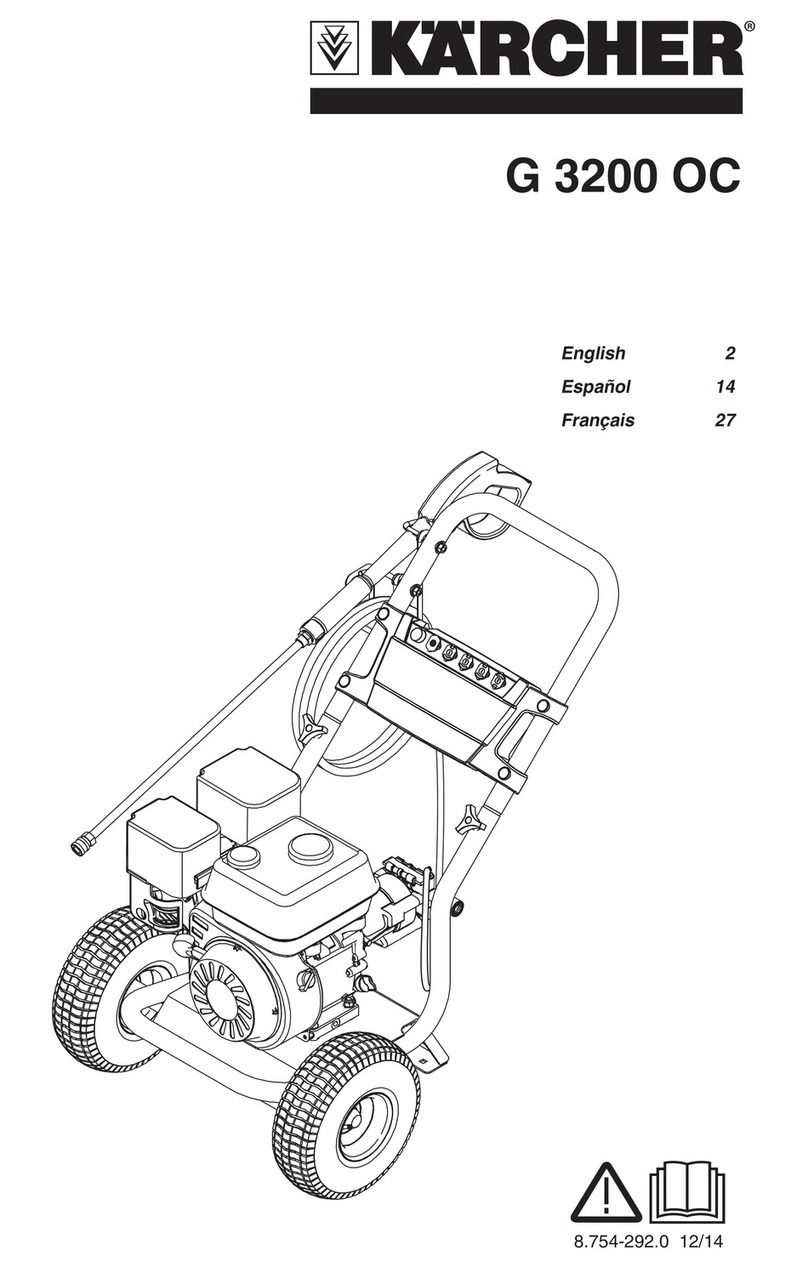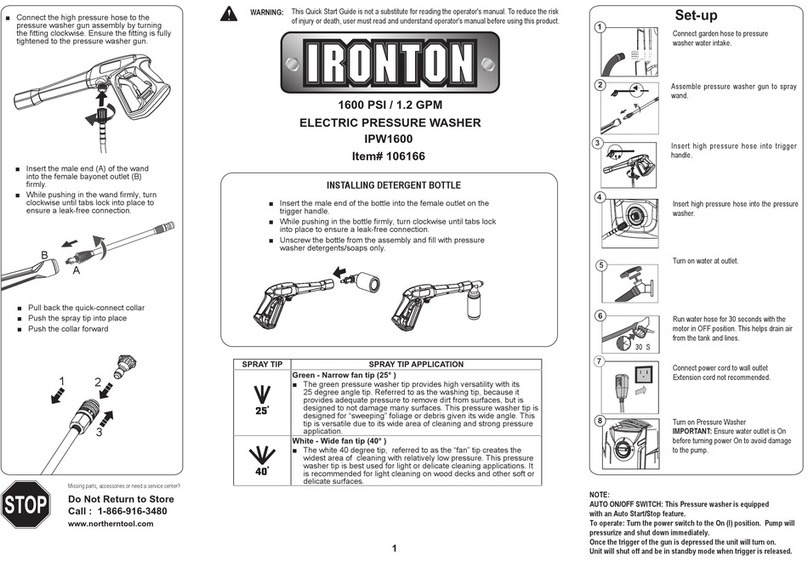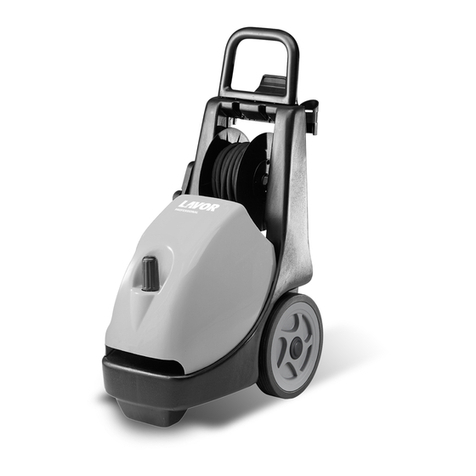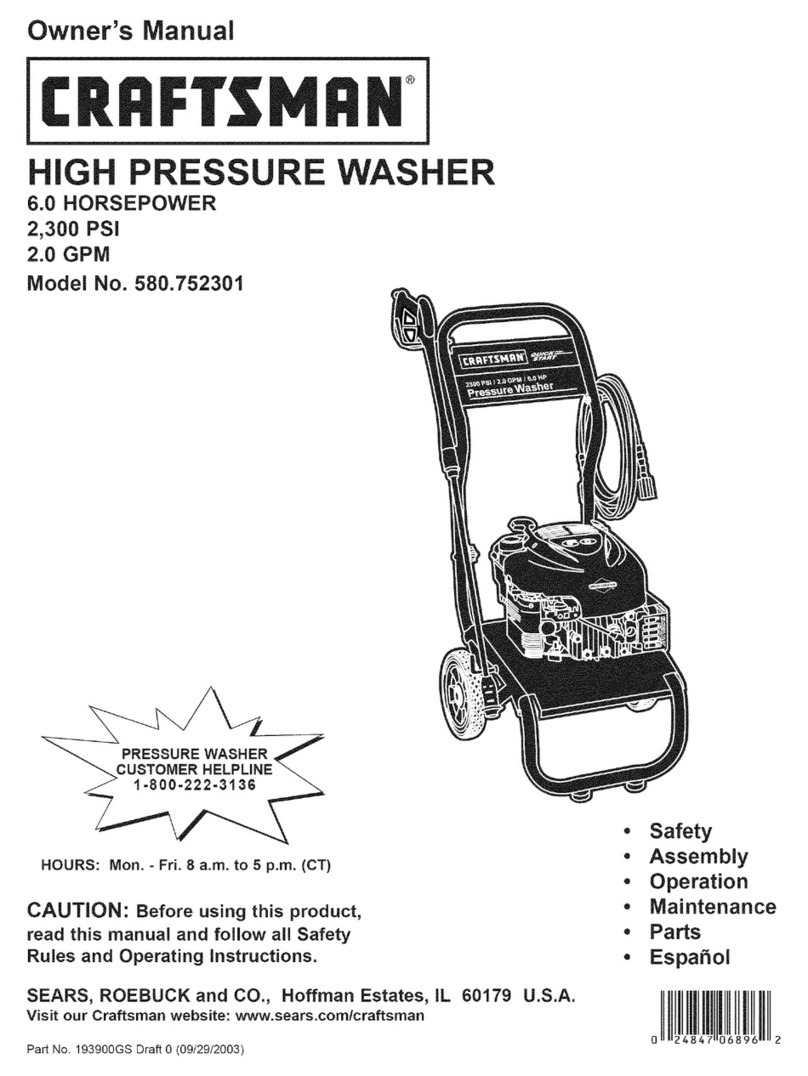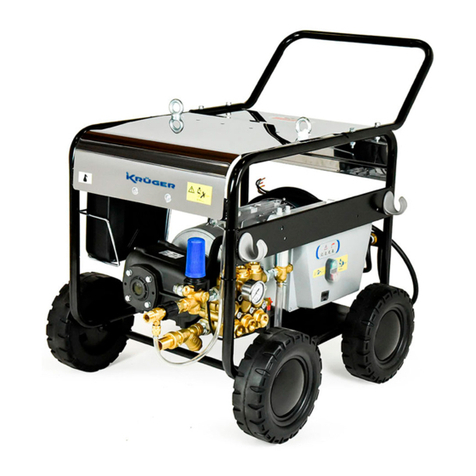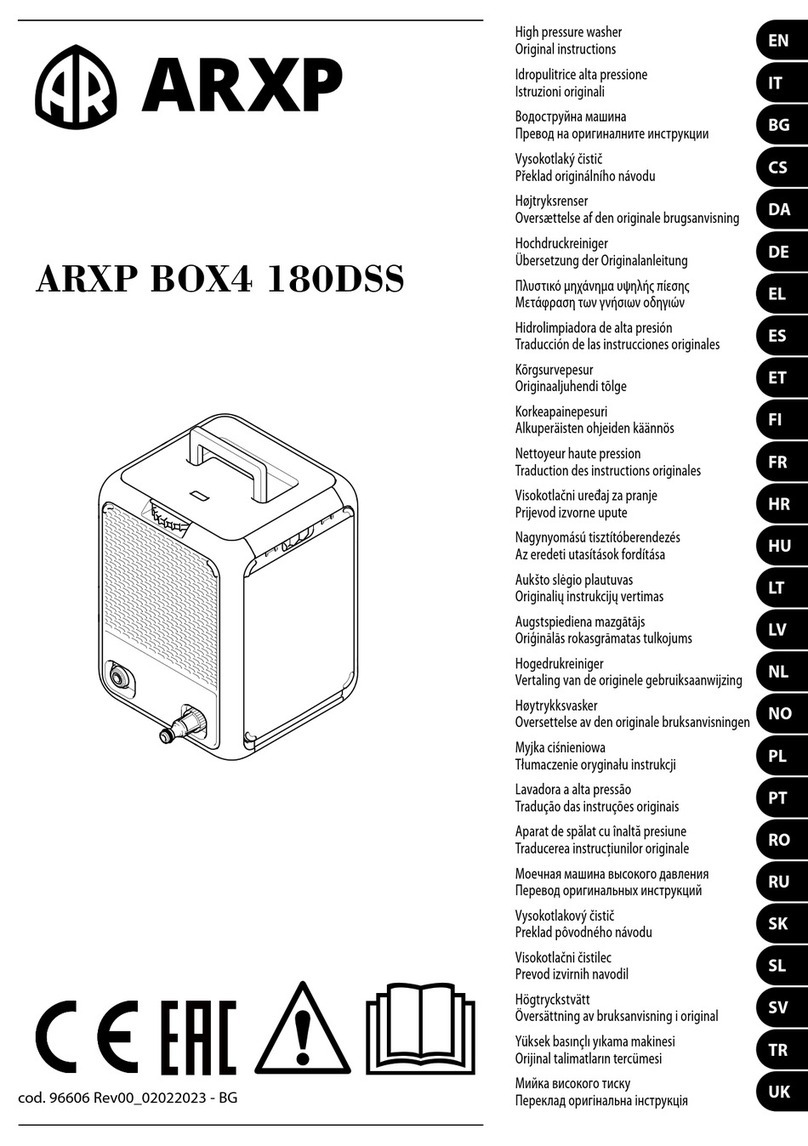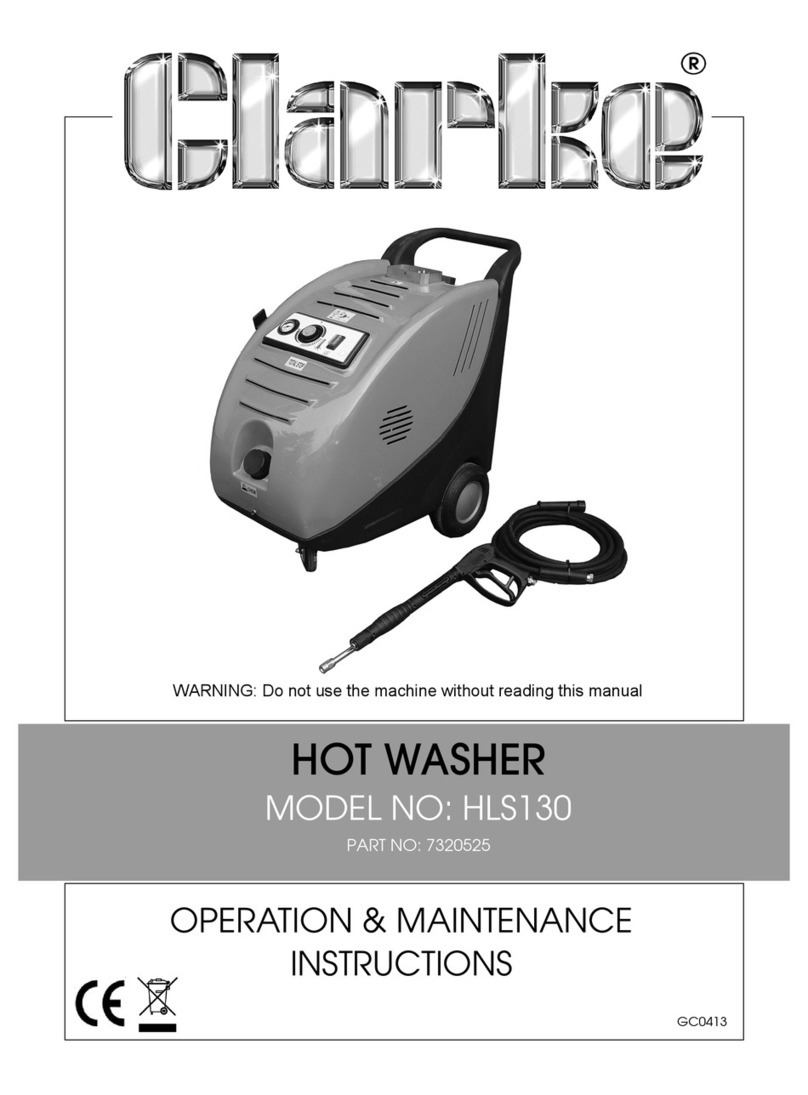Daewoo DGPW3100H-K User manual

Manufactured under license of Daewoo International Corporation, Korea
www.daewoopowerproducts.com
USER'S MANUAL
DGPW3100H-K
Gasoline high pressure washer

INDEX
1. INTRODUCTION
..................................................................................................................................... 2
2. TECHNICAL SPECIFICATIONS
............................................................................................................. 2
3. SAFETY RULES
...................................................................................................................................... 3
4. PRESSURE WASHER FEATURES
......................................................................................................... 6
5. PRESSURE WASHER PARTS ASSEMBLY
........................................................................................... 7
6. PRESSURE WASHER PARTS LIST
....................................................................................................... 8
7. OPERATION
.......................................................................................................................................... 13
8. MAINTENANCE
.................................................................................................................................... 16
9. TROUBLESHOOTING
......................................................................................................................... 16
10. DIAGRAM
............................................................................................................................................ 20
WARRANTY ............................................................................................................................................... 21
1

1. INTRODUCTION
Thank you for purchasing this superior quality pressure washer from Daewoo. When operating and
maintaining this product as instructed in this manual, your pressure washer will give you many years
of reliable service.
2. TECHNICAL SPECIFICATIONS
Power: 5.8 hp / 4.3 kW
Pressure: 214 bar
Flow: 568 L/h
Displacement: 208 cc
Starting method: Recoil
Fuel tank capacity: 3.6 L
Orientation: Horizontal
Life expectancy: 120 hs
Includes: funnel and spark plug wrench.
Detergent tube/filter size: 110 mm
Nozzles: 0° / 15° / 25° / 40°
Standard soap
Product Applications:
• This pressure washer is designed to remove dirt and mold from house siding, decks, garage
floors, brick patios, and cement walkways.
• This unit can be used to clean cars, motorcycles, boats, RV’s outdoor furniture, lawn equipment,
and grills.
2

3. SAFETY RULES
Indicates a potentially hazardous
situation which could result in
serious injury or death if not avoided.
WARNING!
CAUTION!
Indicates a potentially hazardous
situation which could result
in damage to equipment or property.
SAFETY SYMBOLS
Read and understand this manual in its entirety before operating this pressure washer.
Improper use of this pressure washer could result in serious injury or death.
WARNING!
Do not direct the jet against yourself or others in order to clean clothes or foot-wear.
WARNING!
SAFETY INSTRUCTIONS
This machine must be attended during operation. The manufacturer cannot anticipate every possible hazardous circumstance that the
user may encounter. Therefore, the Warning!s in this manual, on tags, and on affixed decals are not all-inclusive. To avoid accidents,
the user must understand and follow all manual instructions and use common sense.
• Spray from this unit has extreme pressure and can ricochet back splashing water or propelling objects towards eyes.
• Never substitute eye protection with dry condition goggles.•
Pressure washer can create puddles and slippery surfaces. Never wear sandals, always wear protective footwear.
• Operate pressure washer from a level and stable surface.
• Do not operate from a ladder, scaffolding, or uneven surface as recoil from spray gun could cause you to fall.
• Do not over-extend yourself in attempt to reach a little further.
WARNING!
This machine has been designed for use with the cleaning agent supplied or recommended
by the manufacturer. The use of other cleaning agents or chemicals may adversely affect
the safety of the machine.
WARNING!
• Do not use the machine within range of persons unless they wear
protective clothing.
Slippery surface Risk of explosionRisk of fire
Risk of electric shock Hot surface Eye protection
Carbon monoxide
Never point the jet at
people, animals, the
device itself or live
electrical devices.
Safety footwear
The unit is
not suitable
for use with
a drinking
water supply!
3

Never spray near a power source such as an electrical outlet. Making contact with
a power source could cause an electric shock or burn.
WARNING!
High pressure cleaners shall not be used by children or untrained personnel.
WARNING!
• Carbon monoxide gas is a poisonous, odorless gas that can cause headache, confusion, fatigue, nausea, fainting,
sickness, seizures, or death. If you start to experience any of these symptoms, IMMEDIATELY get fresh air and seek
medical attention.
•
WARNING! Do not use combustion engine powered machines indoors unless adequate
ventilation is assessed by national labour authorities.
WARNING!
WARNING!
WARNING!
Water that has flowed through backflow preventers is considered to be non-potable.
WARNING!
For gas or oil-heated machines it is important to provide adequate ventilation and make
sure that the flue gases are properly discharged.
WARNING! Incorrect fuels shall not be used as they may prove hazardous
High pressure hoses, fittings and coupling are important for the safety of the machine. Use
only hoses, fittings and couplings recommended by the manufacturer.
WARNING! To ensure machine safety, use only original spare parts from the manufacturer or approved
by the manufacturer.
The machine shall be disconnected from its power source during cleaning or maintenance
and when replacing parts or converting the machine to another function.
WARNING! Do not use the machine if a supply cord or important parts of the machine are damaged,
e.g. safety devices, high pressure hoses, trigger gun.
WARNING! Ensure that any exhaust emissions are not in the vicinity of air intakes.
Never use indoors, in a covered area, or in a confined space, even if doors and windows are open.
Risk of explosion - Do not spray flammable liquids.
WARNING!
4

WARNING! This machine can be used by people with reduced physical, sensory or mental capabilities
or lack of experience and knowledge if they have been given supervision or instruction
concerning use of the machine in safe way and understand the hazards involved.
• The high pressure stream of water produced can cut through skin and underlying tissue. Never squeeze the trigger or
point the spray gun at other people, animals, plants, or fragile objects such as glass, even if the engine is stopped.
• This unit is not a toy. Keep unit away from children and pets.
• Do not leave spray gun unattended while unit is running.
• Make sure the spray gun, nozzle, and accessories are attached correctly.
• Never attempt to repair high pressure hose, always replace.
• Never attempt to repair leaks with sealant, always replace O-ring or seal.
• Never attempt to connect or disconnect hose from pump or spray gun while system is pressurized.
• Always release water pressure from unit every time you stop the engine.
WARNING!
• Do not wear loose clothing or gloves.
• Remove jewelry or anything else that could be caught in moving parts.
• Tie back or wear protective head covering to contain long hair.
WARNING!
High pressure jets can be dangerous if subject to misuse. The jet must not be directed at
persons, live electrical equipment or the machine itself.
Moving parts can catch on clothing, jewelry, and hair.
•
death.
•
on the unit before starting the engine.
• Never smoke while operating or fueling this unit.
•
•
• When adding or draining fuel, unit should be turned off for at least 2 minutes to cool before removing fuel cap. If unit
has been running the fuel cap is under pressure, remove slowly.
• To keep fuel from spilling, secure unit so it cannot tip while operating or transporting.
• When transporting unit, disconnect the spark plug wire and make sure the fuel tank is empty with the fuel shutoff
valve turned to the off position.
WARNING!
alcohol, drugs, medication or you feel tired.
Stay alert and use common sense. Do not operate this unit if you are under the influence of
WARNING!
•
• Allow hot components to cool before touching.
WARNING! Avoid contacting hot areas of this unit.
5

A - High Pressure Hose
B - Fuel Tank
C - Choke
D - Fuel Valve Lever
E - Soap Tank
F - Handle
G - Spray Gun
H - Locking Trigger
I - Pull Cord
J - Engine Switch
K - Dipstick
L - No Flat Foam Filled Tires
M - High Pressure Hose Outlet
N - Water Inlet
A
B
C
D
E
G
H
I
L
J
M
N
K
F
4. PRESSURE WASHER FEATURES
6

5. PRESSURE WASHER PARTS ASSEMBLY
7

6. PRESSURE WASHER PARTS LIST
NUMBER ITEM NAME QTY
1
2
3
4
5
6
7
8
9
10
11
12
13
14
15
16
17
18
19
20
21
22
23
24
25
26
27
28
29
30
31
32
33
34
35
36
37
38
39
40
41
42
Engine
ROUND HEAD BOLT GB/T 818-76 M6X45
GASKET
NUT M6
DETERGENT TANK
DETERGENT TANK CAP
LOWER HOOK
NUT M8
RUBBER FEET
CLIP Q
NUT
ISOLATOR
WHEEL
AXLE
HAIR PIN
LOWER FRAME ASSEMBLY
PLASTIC RIVET
UPPER HOOK
ROTATIONAL SCREW
NOZZLE HOLDER
HANDLE FRAME
FOAM COTTON HANDLE
FASTENER
WIRE
PANEL
PIPE
WATER PUMP
BOLT M8*20
FLAT KEY
LANCE
GUN
HIGH PRESSURE HORSE
PIN
PIN COVER
NOZZLE RED
NOZZLE YELLOW
NOZZLE GREEN
NOZZEL WHITE
NOZZEL SOAP
SPARK WRENCH
CONNECTOR MALE
CONNECTOR FEMALE
1
3
2
3
1
1
1
2
2
3
8
4
2
2
2
1
2
1
6
4
1
1
1
1
1
1
1
4
1
1
1
1
1
1
1
1
1
1
1
1
1
1
8

Packing List
• Pressure washer
• Quick start guide
• Operator’s manual and product registration card
• Spray gun
• Engine manual
• Extension wand with quick-connect fitting
• High pressure hose
• Spray nozzles (5) - 0°, 15°, 25°, 40° and soap nozzle
• Spray gun hook (upper)
• Spray gun hook (lower)
• Accessory hook
• Foot (1)
• 4-Cycle engine oil (SAE10W30)
• Nozzle cleaner
• Turbo nozzle
Do not attempt to assemble or operate this pressure washer until you have read and
understood this entire manual. If you have any problems assembling or operating this unit
contact your dealer or a qualified service center.
WARNING!
Unpacking
1. Remove the high pressure hose from box.
2. After the high pressure hose has been removed, carefully open product by cutting down the sides
of the box.
3. Remove the product, parts, and all accessories. Make sure all items listed on the packing list are
included and not damaged.
Attaching Foot Assembly (See fig 1)
• Parts needed - 1 foot, 1 M8 lock nuts.
• Raise or tilt pressure washer so you can line up foot with the hole located at the centre of the
frame.
• Align the rubber foot with the hole in the frame where the foot is to be located. Attach foot by
inserting the bolt from the
bottom up and install the acorn nut. Wrench tighten until there is a slight crush on the frame tube.
(Do not over tighten)
Do not operate this pressure washer if any of the parts are damaged or missing until the
part is replaced. Using this product with damaged or missing parts can cause damage
to the machine or result in serious injury or death.
WARNING!
9

Install Handle (See fig 2)
• Install upper frame (handle) onto the lower frame by sliding the handle over the two upright tubes
on the lower frame and pressing down firmly until the handle is seated and the two detent pins snap
in place.
FIG 2FIG 1
Attaching Upper and Lower Gun Hooks (See fig 3)
• Attach the upper gun hook, install two plastic rivets, until the plastic rivets are snug, you may need
to tap with a mallet or small hammer to seat the lock pin.
• Attach the lower gun hook, install the M6 screw & lock nut, wrench tighten until the nut is snug, do
not over tighten.
Attaching Accessory Hook (See fig 4)
• Attach the accessory hook.
• Install two plastic rivets, until the plastic rivet is snug.
• You may need to tap with a mallet or small hammer to seat the lock pin.
FIG 4FIG 3
1
2
10

Adding / Checking Engine Oil (See fig 7)
• Place pressure washer on a level surface.
• Remove one or both of the crankcase dipsticks to ensure you do not overfill the engine.
• Carefully add between 520 ml (17.6 oz) of 4-Cycle engine oil (SAE10W30) to empty reservoir until
oil reaches
the outer edge of the oil fill hole (Crackcase Dipstick hole).
• Be sure to replace both dipsticks before attempting to start the engine.
• To check oil, set pressure washer on a level surface, wipe dipstick clean, then reinsert dipstick
without re-threading.
Adding Fuel (See fig 8)
• Set pressure washer on a clean and level surface in an area that is well ventilated.
•Remove fuel cap.
•Insert a funnel into the fuel tank and carefully pour gasoline into the tank until fuel level reaches 1
1/2 inches below the top of the neck.
FIG 7
10W30 OIL
FIG 5
Attaching the Spray Gun (See fig 5 & 6)
• Screw the spray wand and the trigger handle together until they are secure.
• Insert the inlet coupler of the spray hose into the threaded fitting on the high pressure spray gun
and thread the black nut on by turning clockwise until it is hand tight.
FIG 6
11

CAUTION!
CAUTION!
FIG 8
Unleaded
Gasoline
Oil must be added to unit prior to first use.
To avoid spillage, do not overfill fuel tank as gasoline expands.
Do not run pump without connecting to the water supply and turning water on. Failure to
do so could damage the pressure washer. Failure to follow these instructions will
void product warranty. The unit is not suitable for use with a drinking water supply!
CAUTION!
Connecting Garden Hose to Pressure Washer (See fig 9)
• Run water through the hose for a few seconds to flush any debris from the hose.
• Inspect inlet screen and remove any debris.
• Connect hose to water inlet and tighten by hand. There must be a minimum of 10 feet of unrestric-
ted hose between pressure washer and faucet or shut off valve.
• Turn on water.
• Purge the system’s pump of air by releasing the safety and squeezing the trigger of the spray gun.
FIG 9
12

Connect High Pressure Hose to Pump (See Fig 10)
• Attach end of high pressure hose to the high pressure outlet on pump.
• Follow the same procedure with opposite end to attach high pressure hose to spray wand.
FIG 10
7. OPERATION
Pre-Operation Check List
• Read and understand this operator manual in its entirety before operating pressure washer.
• Check oil level and add oil to the proper level if low.
• Check fuel level and add fuel if needed.
• Check connections of handle and all hoses to make sure they are secure.
• Check all hoses for kinks and damage.
• Check flow of water supply and make sure it is adequate (2.8 - 5.6bar).
• Carbon monoxide gas is a poisonous, odorless gas that can cause headache, confusion, fatigue, nausea, fainting,
sickness, seizures, or death. If you start to experience any of these symptoms, IMMEDIATELY
get fresh air and seek medical attention.
• Never use indoors, in a covered area, or in a confined space, even if doors and windows are open.
• Keep exhaust from this unit from entering a confined area through windows, doors, vents, or other openings.
• When working in areas where vapors could be inhaled, use a respirator mask according to all of its instructions.
Do not operate indoors or in a confined space preventing dangerous carbon monoxide
gas from dissipating.
WARNING!
Do not run pressure washer with a damaged hose. Do not run pressure washer without
first connecting and turning on water supply or damage to the pressure washer could
result. FAILURE TO FOLLOW THESE INSTRUCTIONS WILL VOID PRODUCT WARRANTY.
CAUTION!
13

Starting Pressure Washer (See Fig 11-12)
• Place pressure washer on a level surface.
• Turn on water.
• Purge the system’s pump of air by releasing the safety and squeezing the trigger of the spray gun.
• Attach wand/lance to spray gun.
• Turn fuel valve to the ON position.
• Slide the choke lever to the “Choke” position.
• Turn the engine OFF/ON switch to the “ON” position.
• Holding the machine with your hand, pull the recoil handle (starter cord) slowly until resistance is
felt, then pull rapidly.
Squeeze the Gun trigger and release the pressure after every failed attempt to start the pressure
washer (This will reduce the back pressure).
• Let engine run for several seconds and then gradually slide the choke lever to the RUN position as
the engine warms up until the choke is fully slid to the RUN position.
FIG 12
CHOCK RUN
FIG 11
CHOCK
RUN
OFF ON
ON
OFF
Stopping Pressure Washer (See Fig 13)
• Turn the on/stop switch to the OFF position.
• Turn the fuel valve to the OFF position.•
Turn off water and squeeze the trigger handle to release all water pressure.
• Always relieve pressure from spray gun before pulling starter cord, including every failed attempt to start engine.
Pull cord recoils rapidly and pulls arm towards engine faster than you can let go
which could result in injury.
• To avoid recoil, pull starter cord slowly until resistance is felt, then pull rapidly.
WARNING!
FIG 13
ON
OFF
14

FIG 16 FIG 17
SPRAY
WAND
NOZZLE
“CLICK”
0° 15° 25° 40° Soap
WARNING! Kickback forces result from pressing the trigger! Therefore, always hold the spray gun with
both hands! Pay attention to safe posture! Improper handling can lead to injuries!
Using the Spray Gun (See Fig 14 - 15)
• Flip the lock tab behind the trigger up or down until it clicks to apply or remove the safety. Pull
back on the trigger to begin operating pressure washer.
• To stop water flow, release trigger.
FIG 14 FIG 15
TRIGGER
SLOT
LOCK OUT
Using Spray Nozzle (See fig 16-17)
• To connect or disconnect spray tip, pull back on the quick-connect collar. Insert or remove spray
tip then release collar.
• When spray tip is connected, pull on the spray tip to make sure it is secured.
• For general cleaning use the 40° spray tip. This option is for cement walkways.
• For stripping, spot cleaning, blasting, and hard to reach areas use the 15° spray tip. This option is
for removing paint, rust, mildew, marine growth off boats, or grease stains. This option can be used
for reaching second story surfaces, or for the removal of paint, rust, oil stains, tar, gum, and other
stubborn substances. Use extreme caution when using this nozzle.
• For applying pressure washer safe detergent, use the black soap nozzle.
• The angle of the nozzles shown indicates the spray “fan shape” projected from the nozzle when
the trigger of the spray gun is pulled and high pressure water is passing through the nozzle. The
pressure and flow will not change significantly due to the various fan patterns (Nozzles).
15

Applying Detergent
• Rinse surface with cool water before applying cleaner.
• Prepare detergent as required by job. For best results follow detergent directions as supplied from
manufacturer.
• Remove cap from detergent container and fill.
• Spray detergent on surface. For best results use long, even, and overlapping strokes. Allow deter-
gent to set for about 3 minutes before rinsing, but do not allow detergent to dry on surface or it may
cause streaking or cause damage to the surface. Use good judgment.
• To clean equipment after use, flush water through the spray nozzle for 1-2 minutes then shut off
engine. Soak nozzle in a bucket of clean water to remove detergent.
Only use mild, environmentally friendly detergents intended for use in pressure washers.
Ask at your specialist dealer about these special products. Never use aggressive chemicals
(eg bleach), abrasive detergents or similar to avoid damage to your health, the product and
the environment.
WARNING!
Avoid skin contact with detergents, in particular contact with eyes! If detergents gets in
your eyes flush your eyes with clean water and seek immediate medical attention!
WARNING!
Rinsing with the Pressure Washer
• Test a small area first to avoid surface damage.
• Rinse from top to bottom using long, overlapping strokes.
Moving the Pressure Washer
• Turn the pressure washer off.
• Tilt unit towards you until it is balanced on its wheels.
• Roll machine to desired location.
8. MAINTENANCE
Regular maintenance will extend the life of this pressure washer and improve its performance. The
warranty does not cover items that result from operator negligence, misuse, or abuse. To receive full
value from the warranty, operator must maintain the pressure washer as instructed in this manual,
including proper storage.
Pre-operation Steps
Before starting the engine, perform the following pre-operation steps:
• Check the level of the engine oil and the fuel tank level.
• Make sure the air filter is clean.
• Remove any debris that has collected on the pressure washer.
• Check water inlet screen for damage. Clean inlet screen if it is clogged.
• Check high pressure hose for damage.
• Briefly run garden hose to flush out any debris or insects.
• Inspect the work area for hazards.
Before inspecting or servicing this machine, make sure the engine is off and no parts are
moving. Disconnect the spark plug wire and move it away from the spark plug.
WARNING!
16

Remove Debris
• Use a damp cloth to wipe exterior surfaces. If dirt is caked on, use a soft bristle brush.
• Clean any debris that has collected around or behind the muffer, cleaning system, and controls.
After Each UseFollow the following procedure after each use:
Release water pressure by pointing spray gun in a safe direction and squeezing the trigger.
• Shut off engine and turn off water supply.
• Disconnect high pressure hose, spray gun, and nozzle. Drain water from items and use a rag to
wipe down the outside of the hose and spray gun.
• Empty the water from the pump by pulling the recoil starter 6 times.
• Store unit in a clean and dry area.
• Use of a pressure washer pump conditioner is recommended, follow the instructions provided by
the manufacturer of the pump conditioner.
After First 5 Hours Change Engine Oil
After Each Use Check and Clean Water Inlet screen
Check High Pressure Hose
Check and Clean Detergent Siphoning Tube
Check Spray Gun for Leaks
Clean Debris
Check Engine Oil Level before starting
Annually (20 hr Use) Change Engine Oil (Service more often under dirty or dusty conditions)
Annually (50 hr Use) Check and Clean Air Filter
Annually (100 hr Use) Service or Replace Spark Plug
Check muffler and spark arrester
Maintenance Schedule
Changing Engine Oil
Engine oil will drain better if the engine is still warm, but not hot.
• Shut off engine.
• Clean the area around the oil fill cap/dipstick to keep out debris then remove oil fill cap/dipstick.
• Place an oil pan on the ground to catch oil. Remove oil plug then tilt pressure washer back and to
the side to empty out the oil from the crankcase.
• Once oil is completely drained, return the pressure washer to a level position and install the oil
drain plug. Refill the engine with new oil as instructed earlier in this manual under Adding/Checking
Oil.
Oil Drain Plug
17

High Pressure Hose
• Inspect hose for cuts, bulges, or leaks which can develop from kinking or wear. If damage is found,
immediately replace hose.
• Inspect couplings for damage. Immediately replace hose if damage is found.
Spray Gun
• Make sure the spray gun is connected securely.
• Inspect the spray gun safety and make sure the spray gun trigger springs back upon release.
Spray Nozzle
If a pulsing sensation is felt while squeezing the trigger, the spray nozzle may be dirty or clogged
and should be cleaned
immediately.
• To clean the nozzle, shut off the engine and turn off the water.
• Remove the nozzle from the spray wand making sure that the nozzle is pointing away from you and
in a safe direction.
• Use the nozzle cleaner or a small paper clip to dislodge any foreign materials which are clogging
or restricting the
spray tip.
• Flush debris out of the nozzle by back flushing with a garden hose for 30-60 seconds.
• Reconnect the nozzle to the spray wand.
• Turn the water supply back on and start engine.
Checking Spark Plug
• Disconnect the spark plug wire from the spark plug.
• Before removing the spark plug, clean the area around its base to prevent debris from entering the
engine.
• Clean carbon deposits off the electrode with a wire brush.
• Check the electrode gap and slowly adjust to 0.80mm (0.031in.) if necessary.
• Reinstall spark plug and tighten to Torque 22.0 – 26.9 Nm (16-20 ft-lb).
• Reconnect spark plug wire.
• If spark plug is worn replace only with an equivalent replacement part. Spark plug should be
replaced annually.Repairing Leaking Connections
• Purchase O-Ring / Maintenance kits through the nearest authorized service center and follow
instructions provided with kit.
Never repair high pressure hose or use unit if hose is damaged. If hose is damaged replace
with identical Ducar part.
WARNING!
Checking Detergent Siphoning Tube
• Check the detergent siphoning tube for clogs, leaks, or tears.
• Make sure the tube fits tightly to the pump fitting.
• Replace siphoning tubes if damaged.
20
Nozzle Cleaner
18

WARNING! Storage cover could be flammable. Let engine cool before covering pressure washer.
Air filter
A dirty air filter will reduce the life span of the engine, make starting the engine difficult, and reduce
the unit`s performance.
• To clean, remove the air filter cover.
• Carefully pull the air filter out by lifting up along the edges.
• Remove dirt from filter by tapping on it or having it blown out.
• Reinstall air filter so that it seals and replace air filter cover.
• Never attempt to repair high pressure hose, always replace.
• Never attempt to repair leaks with sealant, always replace O-ring or seal.
WARNING! Water pressure produced by this unit can cut through skin and tissue leading to serious
injury and possible amputation.
Storing Pressure Washer
If storing pressure washer for 30 days or more follow the procedures below:
• Add fuel stabilizer to gasoline to keep gasoline from going stale and to prevent gum deposits from
forming on the carburetor. Run engine for a couple of minutes to circulate the fuel stabilizer.• Add
PumpSaver to protect pump from freezing or damage caused by mineral deposits.
• Empty fluid from all hoses and pump.
• Disconnect the spark plug wire and clean the spark plug. Leave spark plug wire disconnected.
• Clean the air filter.
• Cover unit with a suitable protective cover to keep unit dry.
• Store unit in a frost-free area.
19
Table of contents
Other Daewoo Pressure Washer manuals
Popular Pressure Washer manuals by other brands

Mi-T-M
Mi-T-M CA-SERIES Operation manual
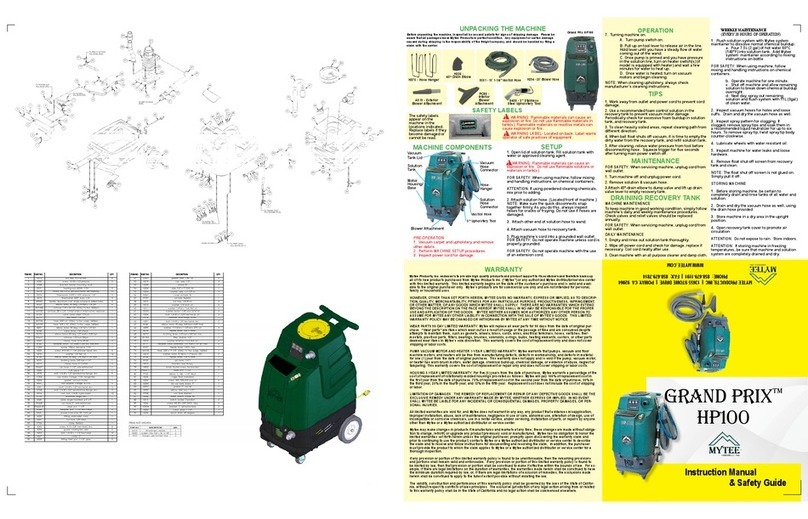
Mytee
Mytee HP100 Grand Prix Instruction manual & safety guide

Troy-Bilt
Troy-Bilt Flex 23AADAAA711 Fast start guide

Kränzle
Kränzle K 1050 P operating manual

Homelite
Homelite UT80993 SERIES Operator's manual

blueclean
blueclean BC383HS Assembly, care and use instructions
